Dive Details
Location
Date
Sunday 16 December 2018
Time
10:35am - 12:13pm
Seas
Slight
Visibility
5 to 20 metres
Duration
98 minutes
Surface interval
Maximum depth
11.3 m
Average depth
8.4 m
Water temperature
17°C
Dive Profile from Garmin Descent Mk1
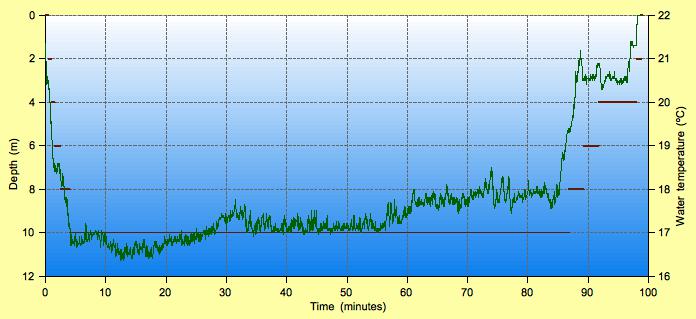
Tides at Botany Bay AEDT
Note that tides at dive site may vary from above location.
High
3:47am
1.27m
Low
9:26am
0.76m
High
3:35pm
1.38m
Low
10:17pm
0.52m
Details
The forecast was for 1.5-2.5 metre north-easterly swell. It was difficult to know how badly Kurnell would be affected so I played it safe and came to Bare Island. At times I could see a lot of white water hitting the shore at Kurnell but at other times it looked calm.
I bumped into Vicki, PJ, and others and Vicki told me about the juvenile weedy seadragons on the eastern side of the island and gave me detailed instructions on how to find them. I decided I'd go look at them for the first dive and then the seahorses on the second dive.
I jumped in just to the south of the pole on the eastern side of the island. I descended and headed east over the kelp until I reached the sand line. The visibility was 15 to 20 metres and I could easily see the layout. I believe I spotted the correct patch of kelp but decided to head south for a bit to check out the area before looking for the juvenile weedy seadragons. I also wanted to find the anchor that people kept mentioning but I had never seen.
I headed south for 10 minutes or so before turning and coming back. I was looking for pygmy pipehorses along the way. Nick Missenden had told me that you can get pygmies along the reef here.
I was still 30 metres from the area for the juvenile weedy seadragons when I came on a male weedy with the remnants of eggs. He had a lot of algae growing over the eggs.
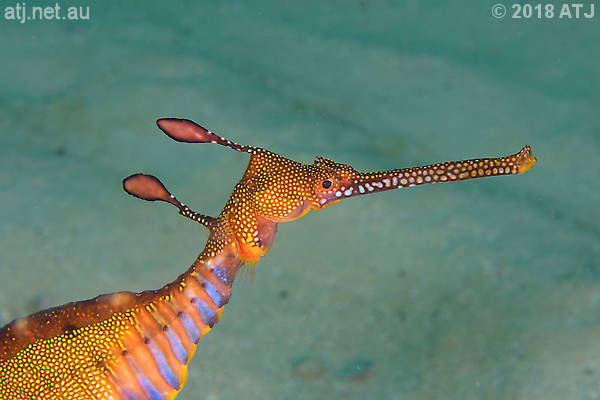
Weedy seadragon, Phyllopteryx taeniolatus. 10.1 m.
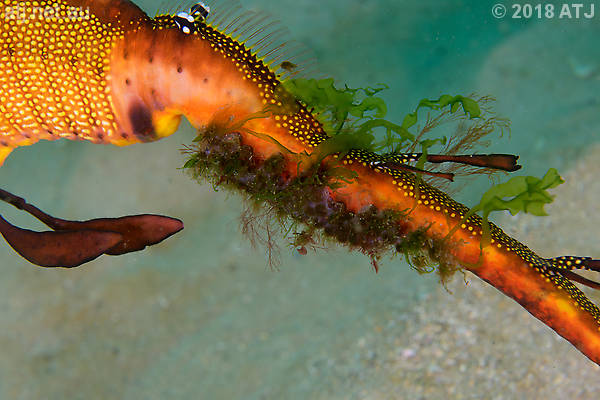
Eggs on the tail of a male weedy seadragon, Phyllopteryx taeniolatus. 10.4 m.
As I approached the area where the juvenile weedies were I could hear a lot of bubbles. There was a divemaster from Abyss with a large group of divers (including Steve Walsh) and he was showing them the juveniles. I hung back to not get in their way. I was pleased with the way the divemaster handled the group and he only let 2 at a time go near the weedies. While they did kick up a lot of sand (kneeling in the bottom and swimming with their hands), the divers did not hassle the juveniles.
Once the group had moved on, I swam in and looked at and photographed the juveniles. I only saw two of them, one slightly larger than the other. I had a brief look in the kelp for others but did not find any.
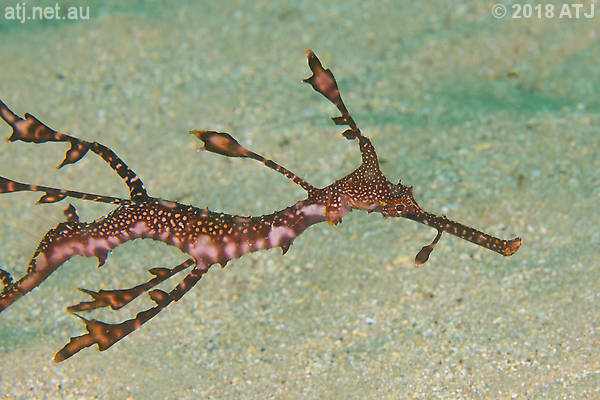
Juvenile weedy seadragon, Phyllopteryx taeniolatus. 9.8 m.
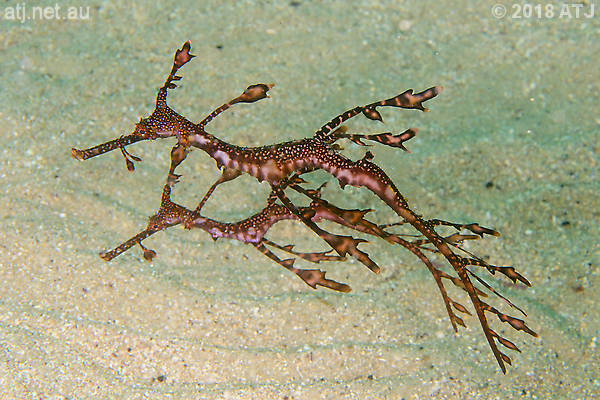
Juvenile weedy seadragons, Phyllopteryx taeniolatus. 9.8 m.

Juvenile weedy seadragon, Phyllopteryx taeniolatus. 9.7 m.
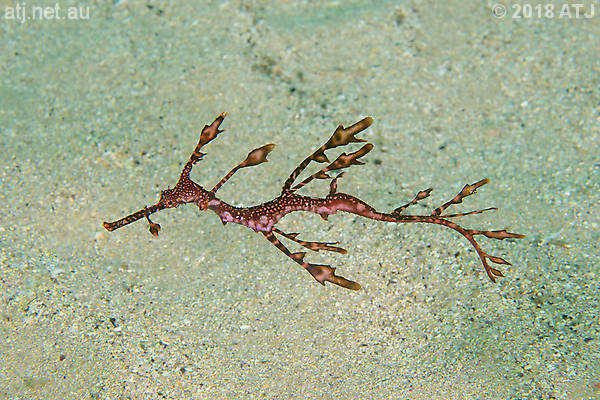
Juvenile weedy seadragon, Phyllopteryx taeniolatus. 9.8 m.
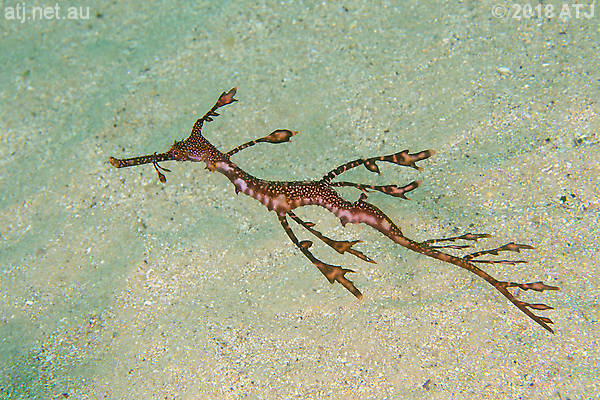
Juvenile weedy seadragon, Phyllopteryx taeniolatus. 9.6 m.

Juvenile weedy seadragon, Phyllopteryx taeniolatus. 9.6 m.
I headed back to the reef and swam slowly north. I checked out the reef for pygmy pipehorses and red-fingered anglerfish but found none. I swam past the caves and then in the gap between the rocks, still looking for pygmy pipehorses and anglerfish.
I swam to the shallows and then up the slope to under the bridge. There was a bit of current here. I swam under the bridge and spotted a large school of striped catfish.
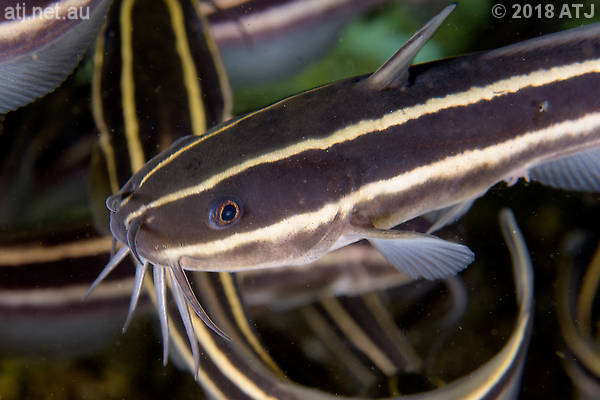
Striped catfish, Plotosus lineatus. 2.9 m.
I headed over the sand to the exit and got out at the rocks near Carol's plaque.
Camera gear
Camera
Nikon D500
Lens
Nikon AF-S Micro Nikkor 60mm f/2.8G ED
Housing
Ikelite 6812.5
Lens port
Ikelite Flat Port 5502.41
Strobes
Ikelite SubStrobe DS125
Ikelite SubStrobe DS161